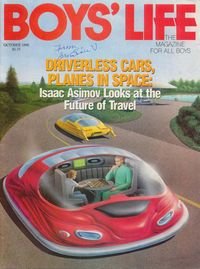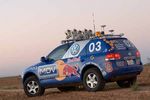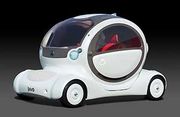Driverless Cars: Difference between revisions
No edit summary |
No edit summary |
||
| Line 4: | Line 4: | ||
{|cellpadding="0" cellspacing="0" style="width: 190px; border: 1px solid #B8C7D9; float:right; margin-left:15px; background:#FBCEB1; text-align:center; font-size: 95%;" | {|cellpadding="0" cellspacing="0" style="width: 190px; border: 1px solid #B8C7D9; float:right; margin-left:15px; background:#FBCEB1; text-align:center; font-size: 95%;" | ||
|- | |- | ||
| style="background: #E32636; padding: 3px 5px; text-align:center;" |''' | | style="background: #E32636; padding: 3px 5px; text-align:center;" |'''Dec. 11, 2008 Update''' | ||
|- | |- | ||
| | | | ||
'' | ''An S-Class Mercedes with all the extras can already be left largely alone to make its way along a moderately busy and fairly straight Autobahn.'' | ||
[http://www.economist.com/science/displaystory.cfm?story_id=12758720 '''The Economist, Dec 11, 2008'''] | |||
|- | |- | ||
|} | |} | ||
Revision as of 16:17, 19 December 2008
In June 1933, William Branham experienced a series of 7 prophetic visions. In the fourth vision, scientific acheivement produced a driverless vehicle, while cars continued to be shaped more and more like an egg. This vision is being fulfilled. With driver assist technologies being integrated into vehicles today, the promise of a fully autonomous individual vehicle on all or designated roadways is possible. The research for autonomous vehicles began in 1977 by the Tsukuba Mechanical Engineering Lab in Japan. The Bundeswehr Universität München in Europe experimented with video-driven cars in the 1980s, and the U.S. experimented with an automated highway system in the 1990s. Today, however, the most promise is in individually autonomous vehicles made possible by advances in computer technology. The next time you read an article about the future of the automobile, remember this prophecy.
Retelling of the 1933 vision:<playmp3>Seventy Weeks of Daniel, August 6, 1961|Driverless Cars.mp3</playmp3>
Industry Commentary
Driverless VehiclesDARPA (Defence Advanced Research Projects Agency)On Sunday October 8, 2005 a modified Volkswagen Touareg named Stanley beat 23 other robotic cars and 150 miles of Nevada Desert to claim a $2 Million prize and the rights to be called the first autonomouns off-road vehicle. Stanley is guided by video, laser, radar and GPS signals, is run by seven on-board Intel Pentiums, and is able to tell the difference between a tumbleweed and a rock. Stanley was invented by a team at Stanford University. Visit the GrandChallenge website for more details. On Saturday November 3, 2007, the Tartan Racing Team (Carnegie Melon) bested Stanley Jr. and Virginia Tech in a 60 mile mock urban course. Not only did these vehicles have to complete the course, they also had to navigate traffic (each other and stunt drivers) and obey all of California's traffic laws. DARPA handed out prizes totaling $3,500,000.[1] [2] The U.S. military has a mandate from Congress to have 30% of all military vehicles unmanned by 2015. The DARPA Grand Challenge and Urban Challenge are part of the U.S. military strategy to achieve this goal. ParkshuttleDeveloped by Frog Navigation (2getthere) and built by Connexion (the Dutch Transit Authority), this bus runs driverless through onboard computers and sensors, together with guiding magnets embedded in the designated roadway. However, Phileas does occasionally need to be manually overridden by a driver. Phileas is already in operation in the Netherlands between the airport and an industrial park.
Egg Shaped Cars - Concept vehiclesNissan PivoOne of the stars of the 2005 Tokyo Auto Show, the Nissan Pivo concept is an electric car with drive-by-wire systems and a revolving egg-shaped cabin. See Nissan's Press Release for more information. Peugot MoovieThe Moovie concept vehicle is driven by two large wheels, the centre of which serves as doors for the vehicle. The Moovie is an electric car designed by Andre Costa in the third Peugot Design Contest, and developed as a prototype by Peugot.
|












